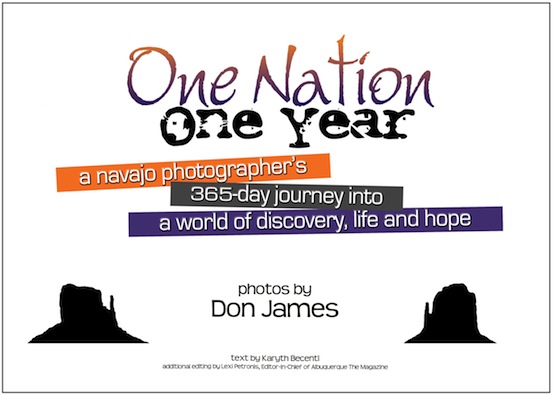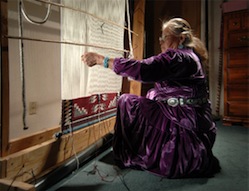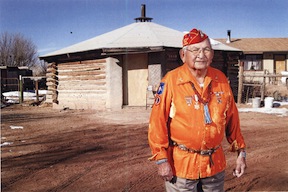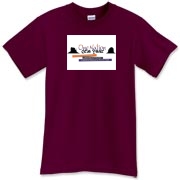A Navajo photographer's 365-day journey into a world of discovery, life, and hope
Photographs by Don James

published by Rio Grande Books
in collaboration with Albuquerque The Magazine
BOOK SIGNINGS
Book signings and events are listed as a master calendar. Check out the calendar by clicking the button below:
March 5, 2011 -- Heard Museum Indian Market, 4022 N. Central Ave, Phoenix, AZ 12 noon - 2pm
July 13, 2010 -- Navajo Nation Museum, Window Rock, AZ 5:30-7:30pm
June 30, 2010 -- Indian Pueblo Cultural Center, 2401 12th St. NW Albuquerque, NM 5:30-7:30pm
June 26, 2010 -- Lavender in the Village, Los Ranchos, NM, 12noon-1pm
June 15, 2010 -- Bookworks, 4022 Rio Grande Blvd NW, Albuquerque, NM 7-8:30pm
June 12, 2010 — Borders at Wyoming, 5901 Wyoming NE, Albuquerque, NM 1-3pm
April 23-24, 2010 — Gathering of Nations, Albuquerque, NM
April 24, 2010 — Indian Arts & Crafts Association Indian Art Market, Albuquerque, NM
April 28, 2010 — Route 66 Casino, Laguna Pueblo, NM, 5:30-7pm
128 pages 213 illustrations
$24.99/PB (978-1-890689-99-5)
BOOK REVIEWS
NATIVE AMERICANS, ARIZONA, NEW MEXICO, UTAH, NAVAJO NATION / Adult / Nonfiction, Photo-documentary:
ONE NATION ONE YEAR: A Navajo Photographer's 365-Day Journey into a World of Discovery, Life and Hope. Culled from over 100,000 photos taken during a 10,000 mile trip by truck, horse, and foot, this is a photojournalistic, boots on the ground look at everyday life today in the Navajo Nation from one who grew up in the region. Praise: Navajo culture photographer Gary Langston (“Captivating, informative and balanced presentation of the diversity, richness and beauty of the Navajo culture.”). Today’s Books editor Lex Ticonderoga puts One Nation One Year on the “A-List!” -- Today's Books/Public News Service
Photographer Documents Everyday Navajo Life and the People Who Live It
The book subtitle is longer than the title, but it efficiently condenses the goal behind the project — "A Navajo photographer's 365-day journey into a world of discovery, life and hope." Don James' journey takes him across the vast Navajo Nation. It begins on Feb. 8, 2008 with Loliane Tsosie, who is pictured tying a hay bale. Another photo is a close-up of her hands; the forefinger on her right hand is missing. It was sliced while mowing in an alfalfa field, the text says. Tsosie grew up ranching in Bowl Canyon, N.M. In between those pages are landscapes, objects, baseball players and portraits that reveal the hard work, pride and endurance of the Navajo people. Among them are saddle bronc rider Jerrick Hildreth of Coolidge, N.M.; Suzie James of Klageton, Ariz., who still shears sheep at age 73; Pete Gilmore, who started a boxing program in Kayenta, Ariz.; Eugene Chee Sr., a pastor in Oljeto, Utah, who preaches when he's not tending sheep; three men who started a consulting firm near St. Michaels, Ariz., that works with clients interested in environmentally friendly technology and alternative energy; Jack Jones, who lives in a small mobile home in Square Butte, Ariz., and must drive 15 miles to fill a tank with water for his home and livestock; and three musicians (Walter Hunter, Roy Ramone and Bobby Mariano) who formed the country band Full Diamond in Prewitt, N.M., in 2003. Short text blocks accompany many photos. The final image in the book is a road sign near Shiprock that thanks motorists for visiting the Navajo Nation and to return for more memories. - - Albuquerque Journal
This coffee-table paperback is the result of an ambitious journey conceived of by Navajo photographer Don James with the support of his employer, Albuquerque The Magazine. The result is a stunning collection of photographs of the Navajo Nation by one of their own from the inside. “To truly do it as an insider, James relied on an expense allowance of only $100 a week to pay for gas, food, and lodging.” This also meant he was relying on the kindness of his own people, the people he was photographing, “the Navajos he met along the way” to “help him tell their story.” Text by Karyth Becenti is at a minimum. The photographs are the heart of the book and tell their own stories without words from a snowy morning near Leupp, Arizona at the edge of the Navajo Reservation, through preparations for a traditional Navajo wedding, a visit with a 70 year old shepherd who still does her own shearing, to corn being planted by a modern young woman in a centuries old tradition, Don James has given us a true insider’s view of a private people. He does it with respect and love, honoring both the old and the new. Cover notes quote James, “I don’t see things the same way anymore…I have more sunshine in my soul now.” This is a lovely book to have on your own coffee table and should be a must for every library in the West. -- Reading New Mexico, May 2010
I was invited to a press event introducing a new book, One Nation One Year by photojournalist Don James, jointly published by Albuquerque The Magazine and LPD Press/Rio Grande Books, 2010. Impressed by the young Navajo photographer/artist, I came away wondering and thinking (all night) about his personal journey in this venture.
Few Anglos know who the Navajo people really are: how they live, how they play, and how they continue to honor their inherited traditions. Many people in the world still picture any Native American Indian in full-feathered headdress.
The young Navajo man Don James lived on $100 a week, traveled 10,000 miles, and took 100,000 photographs in one year covering his one Nation. (Yes, the Navajos are a nation.) He presents us with as personal insight into his people. Traveling from Blackwater, New Mexico, to Shiprock, from Bird Springs, Arizona, to Page, with a jaunt into Utah, it is a book of visuals that will mark a time in history.
Researching the majority of photography books depicting Indians, from Curtis onward, James found they were Anglo-oriented. Don wanted us to see what life is like now in this Nation that is the size of a state. He wanted us to see the iPods, the computers, the jet that carries the Navajo President from Chapter House to Chapter House, the heavy metal bans, and the BMX-style bike jumping competitions. He wanted us to see the environmental technology being studied for Sustainable Development.
Don introduces us to the traditional corn planting, sheep herding, shearing and butchering. He wanted us to see traditional hairstyles, and ceremonials. He wanted us to see the long skirts, turquoise jewelry, and the T-shirts and baseball caps. He wanted us to see the hogans, used as spiritual retreats or housing, even a dog-hogan. He wanted us to see recreational pursuits such as golfing, ice fishing, bike and horse riding and the biggest sport of all, Rodeo competition activities.
Perhaps more importantly, he wanted to pay tribute to his own people, who can say, when leafing through colorful pages, “Oh, I know him.” Or “I know this place.” He wanted to share his one-year experience among them with us, proving that he cares and that he is proud of his heritage. Don’s single year, experienced through photos, will last as a historical document forever. -- New Mexico Breeze by Shirl Brainard
NAVAJO TIMES -- Book takes yearlong look at Diné: Photographer Don James has published about his travels around the Navajo Reservation titled "One Nation One Year."
By Cindy Yurth
If you were on the reservation between Feb. 4, 2008, and Feb. 4, 2009, perhaps you picked up a young hitchhiker with a camera. Perhaps you even let him take your picture for a book he said he was working on - a portrait of the Navajo Nation through the eyes of a Navajo photographer.
Well, Don James' book is finally out. "One Nation One Year" is definitely worth a look. And if your hogan has a coffee table, better clear it off, because this book deserves an honored spot there. While the Navajo are some of the most-photographed people on the planet, and photo books of the reservation abound, this is perhaps the most complete, contemporary look at Navajo life - and the only one by a professional Diné photographer. James, Tsé Nahabilnii (Sleep Rock Clan), born for Tódích'íi'nii (Bitter Water Clan), is a staff photographer for Albuquerque The Magazine who also freelances liberally in the advertising world. Many of the billboards you see driving on I-40 between Albuquerque and Gallup feature his work. James' talent was so obvious he was snapped up by Albuquerque The Magazine before he even finished his bachelor's in fine arts. He has no regrets about going commercial. "It's been a good living for me," he said. But a project kept floating around in the back of his mind, and it wouldn't go away. More of a journey than a project. "I wanted to spend a year on the reservation with no particular goal in mind, just drifting around, photographing what I saw," he said. Long before he had even refined the concept, he had the title: "One Nation One Year."
$100 a week James procrastinated, worried that no publisher would bite. Could the market handle one more book about Navajos? Would publishers yawn in his face? Since he already knew they liked his work, he started with his own bosses at Albuquerque The Magazine, armed with a well researched presentation on all the books out there and how his would be different. He didn't need it. "They loved the idea right away," he said. Rio Grande Books, a small publishing company in Los Ranchos, N.M., which specializes in regional titles, agreed to copublish. So James was off. He was 24. A frugal, Bohemian type, he had saved up enough to live fairly comfortably for a year. But he decided to limit himself to $100 a week.
"I knew it was going to force me to become resourceful," he said. "It was going to force me to meet people. If I spent all my time in hotel rooms, I'd never meet anybody." He drove his Ford Expedition, which doubled as his motel room on nights it was too cold to sleep outdoors and nobody had offered to put him up. When he ran out of money for gas, he hitchhiked. "At first I was going through my week's budget in two days," James said. "By the end of the year, I had money left over." James found he was much happier living simply. Now he's back in Albuquerque, but his apartment isn't much bigger than his Expedition. He doesn't own a TV or a microwave. "The only problem is dating," said the 27-year-old bachelor. "I have trouble convincing girls I'm doing this on purpose. They think I'm just poor."
As he predicted, the bare-bones budget did help him meet people. The nicest kind of people. People who didn't make any more than what James were budgeting offered him a space to sleep on their floor, a shower, and even packed a lunch for him the next day. He was invited to a traditional wedding (which he photographed, of course) and a Kinaaldá, where he was drafted as the fire chief. "I think being a Navajo who was raised on the reservation (his family is from Blackwater, near Prewitt, N.M.) really helped," James said. "I wasn't an outsider. People put me to work." James drifted where the wind blew him or where he could get a ride, and ended up traversing the 27,000-square-mile Navajo Nation several times.
He snapped veterans, sheepherders, musicians, cowboys, farmers, preachers and some folks who pretty much defied categories, like the five buddies in Whippoorwill Chapter who have created a five-hole golf course and never miss a day on the green ... er, brown. He made sure to get the folks with "Navajo star power": President Joe Shirley Jr., the reigning Miss Navajo, James and Ernie, rodeo cowboy Derrick Begay, Code Talker Joe Vandever, Natasha Johnson of "Turquoise Rose" fame. But he also got plenty of Navajos nobody ever heard of, until now. There are pictures of each of the four sacred mountains, and the last few pages are devoted entirely to hogans - 69 of them, all ages, colors, states of repair and materials. "That could have been a book in itself," James said.
The book is 126 pages long but the hard part was deciding which of the 105,000-odd photographs James had collected to leave out. "I work for a magazine, so I understand the concept of editing," he said, "but in this case, I had made so many intimate connections with people. When I left someone's picture out, I felt like I was saying, 'Sorry, you don't get to have your story in here.' "So it was really tough,' he said. 'I might have to make a Web site or something just for the photos that didn't make it in the book." The text is minimal. James mostly lets the pictures speak for themselves. But he does identify almost every one of his subjects, and Diné writer Karyth Becenti fashioned his notes into a descriptive paragraph for each photo, sharing tidbits of Navajo culture to add context for non-Navajos who buy the book. Of the hundreds of photos that did make the book, James' personal favorite is on page 52. A young teenager, Urina Bitcinnie, is planting corn with an old-fashioned planting stick.
She's wearing stylish plaid shorts and Converse tennies, and around her neck hang the unmistakable white wires of iPod
earphones. She's intent on her work, but her full cheeks crinkle in a beautiful smile. "She looks so happy," James said. "To me, that picture says it all. We're traditional people, but we love the modern conveniences when we can get them. We've survived by adapting, but yet the old traditions, the really basic things, live on. "That's the story I wanted to tell. It's the story I think a lot of the other books have missed." "One Nation One Year" is available for $24.99 from http://nmsantos.com/ (where you can also vote for James to get a Pepsi grant to frame and exhibit his photos). It's also on amazon.com and at the Navajo Nation Museum gift store. James is planning an official launch party at the museum on Aug. 28, and he's inviting all the people he photographed on his journey.
"I would love to get them all together in one room and see what happens," he said. As for future projects, he's thinking of a sort of "The Making of One Nation One Year." "Every one of these pictures has a story attached," he said. "How I met the person, what I did with them ... I was telling one journalist about it while she was interviewing me, and she said, 'That's as interesting to me as the pictures. I would love to write about that.' So we'll see." For James, anything that helps him relive 2008 is welcome. "It was the best year of my life," he said. "I'd do it again tomorrow if I could."



ABOUT THE EDITOR:
Edited by Navajo writer Karyth Becenti, the narrative that accompanies the images are succinct and enlightening, offering the viewer the chance to at once see the Navajo people and feel a small piece of their lives.
“One Nation, One Year” is a photographic journey that transcends borders, languages, distance, time, and cultural barriers. For one year, Navajo photographer Don James drove from one side of the Navajo Nation to the other documenting arts, traditions, sports, and people. He travelled by dirt road, horseback, on foot—even as a hitchhiker— for more than 10,000 miles and took over 105,000 photographs. The Navajo Nation and its people have been extensively photographed over the last century, but rarely from the eye of one of its own. Because he’s native, and knows the land and people, James embarks on a journey to show the world a different view of his culture, through his eyes and his Nikon lens. His understanding of the Navajo gives us a glimpse at a people previously off-limits to outsiders.


